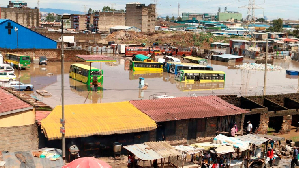 Buses stuck in floodwater at Kware area of Pipeline estate in Nairobi, Kenya on May 1, 2024.
Buses stuck in floodwater at Kware area of Pipeline estate in Nairobi, Kenya on May 1, 2024.
Floods in Kenya killed at least 169 people between March and April 2024.
The most catastrophic of these deaths occurred after a flash flood swept through a rural village killing 42 people. Death and destruction have also occurred in the capital, Nairobi, a stark reminder of the persistent failure to keep abreast of the city’s rapid urbanisation needs.
Sean Avery, who has undertaken numerous flood and drainage studies throughout Africa, unpacks the problems and potential solutions.
Are floods in Kenya causing more damage? If so, why?
Floods are the natural consequence of storm rainfall and have an important ecological role.
They inundate flood plains where silts settle, riverbed aquifers are recharged, and nutrients are gathered.
Annual rainfall in Kenya varies from 2,000mm in the western region to less than 250mm in the drylands covering over 80 percent of Kenya. But storm rainfalls are widespread. This means that floods can occur in any part of the country.
The impact of floods has become more severe due to a number of factors.
Third, flood risks are worse for people who have settled in vacant land which is often in low-lying areas and within flood plains. In these areas, inundation by flood waters is inevitable.
Fourth, Nairobi’s persistent water supply shortages have led to a proliferation of boreholes whose over-abstraction has resulted in a dramatic decline in the underground water table’s levels. This leads to aquifer compression, which is compounded by the weight of buildings. The result is ground level subsidence, which creates low spots where storm water floods collect.
What should be done to minimize the risks?
Rural areas require a different set of solutions.
Natural watercourses throughout Kenya are being scoured out by larger floods due to land use pressures. These watercourses are expanding, and riparian vegetation cover is disappearing. The flood plains need space to regenerate the natural vegetation cover as this attenuates floods, reducing the force of runoff and erosion.
There are existing laws to protect riverbanks, and livestock movements in these areas must also be controlled. Any building or informal settlement within riparian areas is illegal and would otherwise be exposed to the dangers of floods. Enforcement is a challenge, however, as these areas are favoured by human activities and often these people are among the poorest.
Urban areas have a host of particular challenges that need to be addressed.
Take Nairobi, Kenya’s capital city. The physical planning process is hindered by corruption. Inappropriate and unsafe developments proliferate alongside inadequate water supply, wastewater and solid waste disposal infrastructure.
Sewage effluent is often discharged into stormwater drains, even in high-class areas of the city. And there is little control of development in the growing urban centres bordering Nairobi, with transport corridors being congested. Throughout the country, laws that protect riparian zones are flouted.
None of this is sustainable.
Each municipality is obliged to provide infrastructure that includes an effective engineered stormwater drainage network. And in parallel, wastewater and solid wastes must be separately managed.
The typical stormwater drainage network comprises adequately sized earth and lined channels, and pipes and culverts that convey the stormwater to the nearest watercourse. Constant maintenance is essential, especially before the onset of rains, to avoid blockage by garbage and other human activities.
Modern-day urban flood mitigation measures include the provision of flood storage basins. Unfortunately, this is impossible in Nairobi where developments are built right up to the edge of watercourses. Constrained channels thereby cause upstream flooding as there is nowhere else for the water to go.
Attempts have been made to reverse urban riparian zone encroachments, but these efforts faltered due to legal repercussions. To this day, unscrupulous developers encroach with impunity.
It’s essential that the authorities demarcate riparian boundaries and set aside buffer zones that cannot be “developed”.